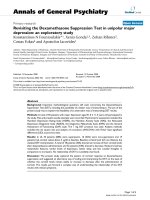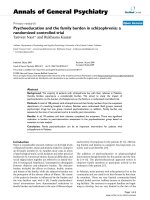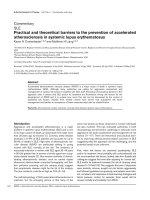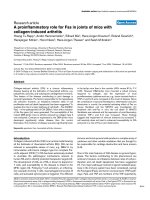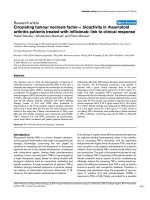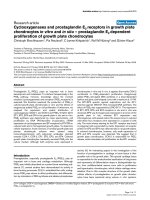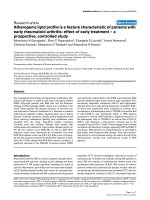Báo cáo y học: " Mucociliary and long-term particle clearance in airways of patients with immotile cilia" doc
Bạn đang xem bản rút gọn của tài liệu. Xem và tải ngay bản đầy đủ của tài liệu tại đây (381.68 KB, 8 trang )
BioMed Central
Page 1 of 8
(page number not for citation purposes)
Respiratory Research
Open Access
Research
Mucociliary and long-term particle clearance in airways of patients
with immotile cilia
Winfried Möller*
1
, Karl Häußinger
2
, Löms Ziegler-Heitbrock
2,3
and
Joachim Heyder
1
Address:
1
Institute for Inhalation Biology and Clinical Research Group 'Inflammatory Lung Diseases', GSF – National Research Centre for
Environment and Health, Robert Koch Allee 29, D-82131 Gauting-Munich, Germany,
2
Department for Respiratory Medicine, Asklepios Hospital
Munich-Gauting, Robert Koch Allee 2, D-82131 Gauting-Munich, Germany and
3
Department of Infection, Immunity and Inflammation,
University of Leicester, Medical Sciences Building, Leicester LE1 9HN, UK
Email: Winfried Möller* - ; Karl Häußinger - ; Löms Ziegler-Heitbrock - ;
Joachim Heyder -
* Corresponding author
Abstract
Spherical monodisperse ferromagnetic iron oxide particles of 1.9 µm geometric and 4.2 µm
aerodynamic diameter were inhaled by seven patients with primary ciliary dyskinesia (PCD) using
the shallow bolus technique, and compared to 13 healthy non-smokers (NS) from a previous study.
The bolus penetration front depth was limiting to the phase1 dead space volume. In PCD patients
deposition was 58+/-8 % after 8 s breath holding time. Particle retention was measured by the
magnetopneumographic method over a period of nine months. Particle clearance from the airways
showed a fast and a slow phase. In PCD patients airway clearance was retarded and prolonged,
42+/-12 % followed the fast phase with a mean half time of 16.8+/-8.6 hours. The remaining fraction
was cleared slowly with a half time of 121+/-25 days. In healthy NS 49+/-9 % of particles were
cleared in the fast phase with a mean half time of 3.0+/-1.6 hours, characteristic of an intact
mucociliary clearance. There was no difference in the slow clearance phase between PCD patients
and healthy NS. Despite non-functioning cilia the effectiveness of airway clearance in PCD patients
is comparable to healthy NS, with a prolonged kinetics of one week, which may primarily reflect
the effectiveness of cough clearance. This prolonged airway clearance allows longer residence
times of bacteria and viruses in the airways and may be one reason for increased frequency of
infections in PCD patients.
Introduction
Mucociliary clearance (MCC) is an integral part of lung
defense mechanisms, enabling efficient clearance of
inhaled particles, including microorganisms, from the res-
piratory tract [1,2]. Airway infections and ciliary dysfunc-
tions can lead to impaired mucus transport [3,4] and can
thereby enhance the fraction of retained particles, includ-
ing microorganisms in the airways. In addition, the defect
in ion transport across the airway epithelia of cystic fibro-
sis (CF) patients [5] is thought to impair MCC [6,7], con-
tributing to chronic infection in these patients.
Primary ciliary dyskinesia (PCD) is a pulmonary disorder
manifested by abnormal MCC [8,9], in this case due to
immotile cilia that do not beat in a coordinated fashion to
propel mucus out of the lung. In the last years it has been
Published: 19 January 2006
Respiratory Research 2006, 7:10 doi:10.1186/1465-9921-7-10
Received: 26 September 2005
Accepted: 19 January 2006
This article is available from: />© 2006 Möller et al; licensee BioMed Central Ltd.
This is an Open Access article distributed under the terms of the Creative Commons Attribution License ( />),
which permits unrestricted use, distribution, and reproduction in any medium, provided the original work is properly cited.
Respiratory Research 2006, 7:10 />Page 2 of 8
(page number not for citation purposes)
shown that PCD is a genetic disease characterized by
abnormal ciliary ultrastucture and function (microtubular
apparatus), impaired MCC, and chronic lung, sinus and
middle ear disease [10]. Situs inversus occurs randomly in
approximately 50% of subjects with PCD [11]. Yet,
despite deficient MCC patients with PCD appear to fare
better clinically (i.e., lower infection rates and decline in
lung function) than CF patients [12]. It may be that PCD
patients have sufficient clearance from their small airways,
as suggested by recent studies of Svartengren and col-
leagues [13], either by very efficient cough clearance that
extends out to the small airways or other, as yet unde-
fined, mechanisms capable of transporting mucus in their
airways.
Using gamma scintigraphy, MCC has generally been
assessed by measuring the rate of removal over time of
radiolabelled particles deposited in the lungs following
their inhalation under tidal breathing conditions. The rate
of particle clearance from the airways is determined by the
integral function of the various components comprising
the mucociliary escalator (i.e., frequency and coordina-
tion of ciliary beating and rheology of airway secretions).
Traditionally it has been assumed that particles depositing
on the ciliated airways are rapidly cleared by mucociliary
clearance during the first 24 hours following deposition,
and that any particles remaining in the lung at 24 hours
represents alveolar or "non-ciliated airway" deposition
[14-16]. More recent studies suggest that the 24-hour
retention of radiolabelled inhaled particles, especially in
patients with obstructive pulmonary disease, may reflect
in part long-term airway retention [17-21], and this was
also included in the recent ICRP model of clearance of
particles from the lung [22].
Human studies using the bolus inhalation technique have
shown that MCC removes all deposited particles larger
than 6 µm from the airways within 24 hours. When
smaller particles are inhaled, a certain fraction is retained
for longer than 24 hours [17,23]. This fraction increases
with decreasing particle size. The mechanisms of this
long-term clearance of particles from the airways are
unclear. In a recent study we have shown that in healthy
non-smokers (NS) the kinetics of long-term retained par-
ticles from the airways is very slow, and comparable to
that of alveolar clearance of the same type of particles
[24]. In this study a magnetic labeling method was
applied enabling observation times of up to one year
without radioactive burden to the subjects.
The purpose of this study was to evaluate both, the short
term mucociliary and the long-term clearance kinetics of
inhaled magnetic iron oxide particles from the airways of
patients with immotile cilia using the magnetic labeling
method (Magnetopneumography, MPG) [25,26], and to
compare the results to data on healthy NS, obtained from
a previous study [24]. The MPG method has been applied
to investigate long-term clearance from the lung periphery
over a 1 year period [27], which result in clearance half-
times of ≈ 120 days for healthy NS and impairment of
clearance due to cigarette smoking and interstitial lung
diseases. Studies on patients with immotile cilia may pro-
vide new insight into the understanding of clearance stud-
ies after shallow bolus inhalation.
Studies of airway clearance require a deposition of the test
particles predominantly in the airways. Efforts were made
to achieve this requirement by controlled inhalation of
particle boli at the end of tidal inhalation [28,29]. The
phase1 volume of the anatomical dead space was used as
a threshold volume for the bolus penetration depth.
Methods
Subjects and pulmonary function testing
Seven patients with immotile cilia syndrome (age 35 +/-
12 years) participated in the study. Anamnestic data were
collected using a questionnaire based on ATS – recom-
mendations [30], and all subjects were interviewed by a
pulmonary specialist. PCD was confirmed by clinical his-
tory and ciliary ultrastructural abnormalities observed by
electron microscopic investigation of nasal or bronchial
biopsies from each patient [31,32]. Two of the PCD
patients had situs inversus totalis and five had clinical and
radiological evidence of bronchiectasis. During the first
month of clearance measurements none of the PCD
patients used oral or inhalative steroids.
The protocol was approved by the Ethical Committee of
the Medical School of the Ludwig Maximilian University
(Munich, Germany), and informed consent from each
subject was obtained. Body plethysmography and spirom-
etry were performed using a Jäger Masterlab (Erich Jäger,
Würzburg, Germany). Predicted values of conventional
lung function parameters were calculated by normalizing
to the reference values proposed by the European Com-
munity for Steel and Coal [33]. A lung function test and
an MPG measurement of the natural ferromagnetic con-
tamination of the lungs of every subject were obtained
before inhalation. MPG measurements were performed
30 min, 3 and 6 hours, 1 and 2 days, 1 week, 1, 3, 6 and 9
months after particle inhalation. Reference data of 13
healthy never-smoking subjects (NS, age 37 +/- 11 years)
were taken from a previous study [24].
Volumetric dead space measurement
A fast mass spectrometer (modified magnetic sector field
mass spectrometer; DLT 1100 R, Dennis Leigh Technol-
ogy, Sandbach UK) was used to measure the physiological
dead space [34]. A tracer gas mixture, composed of 0.2%
C
18
O
2
, 21% O
2
, and 78.8% N
2
was applied as a single-
Respiratory Research 2006, 7:10 />Page 3 of 8
(page number not for citation purposes)
breath inhalation. CO
2
labelled with the stable oxygen
isotope
18
O (C
18
O
2
) was completely taken up in the gas
exchanging region of the lung, but not from the airways.
Therefore C
18
O
2
was only expired from the dead space of
the lung, and not from the alveolar region. Hence, C
18
O
2
allows the measurement of the respiratory dead space not
only in healthy subjects, but also in patients with COPD
and lung emphysema [35,36]. The physiological dead
space V
FD
was derived from the C
18
O
2
expirogram using
the method of Fowler [37]. In addition the phase1 dead
space volume, V
DP1
, was estimated from the C
18
O
2
con-
centration drop to below the 95 % level as a closer thresh-
old volume for the conducting airways.
Magnetic particle generation, inhalation and
Magnetopneumographic detection
The system for magnetic particle generation, inhalation
and detection in the lung is described in detail in the pre-
vious study [24] and will therefore be repeated here only
very shortened. 0.5 – 1 mg of spherical monodisperse fer-
rimagnetic iron oxide particles (Fe
3
O
4
, 4.2 µm aerody-
namic, 1.9 µm geometric diameter, σ
g
< 1.1) were
deposited in the lungs by controlled voluntary inhalation
of a shallow 100 cm
3
aerosol bolus using the respiratory
aerosol probe (RAP) [29]. The particles were produced by
a Spinning Top Aerosol Generator (STAG) [38]. The mean
inhalation and exhalation flow rates were kept at 250 ml/
s. The volumetric front depth V
F
of the aerosol bolus was
adapted to the individual phase1 dead space volume V
DP1
.
At the end of inhalation, an 8 s breath hold was performed
in order to enhance the particle deposition. The end-
inspiratory volume was 1 L above the functional residual
capacity (FRC). The lung expansion of the dead space
measurements was 90 % TLC and therefore larger com-
pared to that of the aerosol administration. Therefore the
volumetric dead space during aerosol administration
requires a 10 % reduction, as can be estimated from the
data in Bennett et al. [39]. About 20–30 breath were nec-
essary to deposit 0.5 – 1 mg of magnetite particles in the
lung.
Directly after inhalation the particles deposited in the
lungs were detected by the Magnetopneumographic
(MPG) system [26]. The subjects were positioned on a bed
with the lungs directly under the magnetizing coils (mag-
net). Magnetization was carried out in a short magnetic
field pulse. The magnetized particles formed remanent
magnetic dipoles, oriented parallel to the magnetizing
field and therefore produced a weak remanent magnetic
field (rmf) of the lung. The subject was moved under a
superconducting loop array where the weak magnetic
field of the lungs was detected by a superconducting
quantum interference device (SQUID). After correcting
for natural ferromagnetic contamination, the rmf detected
was shown to be a reliable measure of the amount of par-
ticles retained within the lungs [40]. Subjects were studied
over an 8 – 9 month post-inhalation period.
Data analysis
Particles deposited in the lung by the shallow bolus tech-
nique showed at least two different mechanisms of clear-
ance. The first fast phase happened within the first days
and later proceeded into the slow phase of clearance. The
course of the clearance curve was fitted by the sum of two
exponential functions according to:
where B
0
describes the amount or retained magnetic mate-
rial directly after inhalation, (1-A
S
) describes the amount
of fast cleared material with the time constant T
F
, A
S
describes the amount of slowly cleared material, T
S
is the
time constant of the slowly cleared material. Additionally
the amount of retained material after 6 hours, 24 hours, 1
week and 9 month (ret6 h, ret24 h, ret1 w and ret9 m) was
analyzed. The significance of differences in the data
between PCD patients and healthy NS (reference data
obtained from [24]) were analyzed by a two-sided t-test.
Results
Data of pulmonary function testing, of anatomic dead
space and of particle inhalation
Age and lung function data of the seven PCD patients are
shown in Table 1. Five of the seven subjects had lung func-
tion data in the normal range of healthy subjects. In two
of the seven subjects FEV1 was below the 80 % and FEV1/
VCmax was below the 70 % threshold of healthy subjects,
respectively, classifying them as obstructive patients
(moderate COPD, type IIA) according to GOLD recom-
mendations [41]. Mean VCmax and FEV1 were signifi-
cantly lower in PCD patients compared NS, while
RV%TLC was significantly higher. The dead space meas-
urements gave mean values for V
DF
and V
DP1
at a lung
inflation of 90 % TLC of 290 +/- 54 ml and 173 +/- 36 ml,
respectively. Among all subjects V
DP1
shows a high corre-
lation to the body height (cc = 0.78, p < 0.01). The mean
aerosol penetration front depth during bolus inhalation
was V
F
= 157 +/- 15 ml. The aerosol bolus was adminis-
tered at the end of a 1 liter breath from FRC, where the
mean lung expansion was 67 +/- 9 %. In order to adapt the
lung inflation of the dead space measurements to the aer-
osol inhalation a reduction of the dead space volumes of
about 10–15 % is necessary according to data in [39] and
our few measurements. The bolus penetration (front
depth) in relation to the Fowler dead space and the
phase1 dead space is 59 % of V
DF
and 100 % of V
DP1
as cor-
rected to 70 % TLC lung expansion. After 8 seconds of
breath holding time during aerosol inhalation the mean
deposition was D
AW
= 58 +/- 8 % compared to 51 +/- 8 %
Bt B A
t
T
A
t
T
S
F
S
S
( ) (( )exp( ) exp( ))=− −+ −
0
1
Respiratory Research 2006, 7:10 />Page 4 of 8
(page number not for citation purposes)
in healthy NS (from [24]). The deposition without breath
hold was below 20 %. The bolus penetration depth V
F
and
the phase1 dead space volume, V
DP1
are correlated (cc =
0.82, p < 0.01).
The aerodynamic and the geometric particle size was 4.14
+/- 0.36 µm and 1.87 +/- 0.16 µm in PCD patients, respec-
tively. The particle size distribution obtained by sedimen-
tation cell measurements revealed a geometric standard
deviation of σ
g
< 1.1, therefore, the particles can be char-
acterized as monodisperse. The particles were very com-
pact (density ρ = 4.9 g/cm
3
), chemically stable, and resist
dissolution in physiological saline, in body fluids, and in
the lungs for several month.
Fast clearance of particles from the airways
The retention of the ferromagnetic iron oxide particles
was measured in the MPG-system directly after, in addi-
tion to 3 hours, 6 hours, 1 day, 2 days, 1 week, 1 month,
3 months, 6 months and 9 months after inhalation. The
individual retention curves of all seven PCD patients are
shown within the first day and within the first week in Fig-
ure 1 and in Figure 2, respectively (in comparison to
healthy non-smokers from a previous study, mean +/-
standard deviation, SD). The data follow a two phase
decay with a fast phase within the first week, and a slow
phase over the following months. The mean data of the
half times of the two phase decay and the fraction of clear-
ance following the slow decay (A
S
) are given in Table 2.
After 6 h and after 1 day, 88.8 +/- 5.3 % and 72.6 +/- 6.6
% of the particles were retained in the lung in PCD
patients, respectively (64.1 +/- 8.7 % and 49 +/- 8 % in
healthy NS [24], p < 0.01). After 1 week, 54.8 +/- 11.0 %
of the particles were retained in the lung in PCD patients
(45.7 +/- 8.2 % in healthy NS [24], difference not signifi-
cant, n.s.). Extrapolating the long-term decay back to time
zero reveals that 57 +/- 12 % of the particles follow the
slow phase of retention (50 +/ 8 % in healthy NS [24],
n.s.). Only ≈ 50 % of the particles depend on the mucocil-
iary fast clearance mechanism, which happens with a half
time of T
1/2F
= 16.8 +/- 8.6 hours (T
1/2F
= 3.0 +/- 1.6 hours
in healthy NS [24], p < 0.01).
Slow clearance of particles from the airways
The slow phase of airway clearance of 1.9 µm geometric
diameter iron oxide particles is shown in part in Figure 2.
Within the first week ≈ 50 % of the particles were cleared
via the mucociliary apparatus and the remaining particles
followed a mean clearance half time of T
1/2S
= 121 +/- 25
days in PCD patients (T
1/2S
= 109 +/- 78 days in healthy
NS, n.s.), 270 days measurement time. After 9 month 14
+/-5.0 % of the initially deposited particles are retained in
the lungs of PCD patients (10 +/-9.8 % in healthy NS
[24]). Long term airway particle clearance in PCD patients
shows no significant difference to healthy NS. Attempts to
include an intermediate clearance phase into the model
failed.
Discussion
Particle deposition
Particle penetration was confined to the phase1 dead
space volume of the airways by using the bolus technique.
Table 1: Age and lung function data of the seven PCD patients involved in the study
Age TLC FRC RV VCmax Rtot FEV1 FEV1
Subj. Years %pred %pred %pred %pred kPa*s/l %pred %VCmax
#1 27 99 96 100 98 0.18 92 82.1
#2 35 110 124 158 90 0.3 68 65.9
#3 34 101 111 118 96 0.22 85 71.2
#4 42 98 112 124 88 0.31 57 52
#5 23 110 121 126 105 0.18 94 72.3
#6 28 91 84 87 93 0.26 93 79.9
#7 57 95 82 92 100 0.12 106 79.6
Mean 35.1 100.6 104.3 115.0 95.7** 0.22 85.0* 71.9
SD 11.5 7.2 17.1 24.5 5.9 0.07 16.9 10.5
(*: p < 0.05; **: p < 0.01 for PCD patients versus reference data from a previous study [24]).
Table 2: Results of the measurement of the clearance curve
parameters
Unit Mean +/- SD
Clearance
A
s
0.57 +/- 0.12
T
1/2f
hours 16.8 +/- 8.6**
T
1/2s
days 121 +/- 25
Retention
Ret6 h % 88.8 +/- 5.3**
Ret1 d % 72.6 +/- 6.6**
Ret1 w % 54.8 +/- 11.0
Ret9 m % 13.9 +/- 5.4
(Ret6 h, 1 d, 1 w and 9 m are retention data after 6 hours, 1 day, 1
week and 9 months; *: p < 0.05; **: p < 0.01 for PCD patients versus
reference data from a previous study [24]).
Respiratory Research 2006, 7:10 />Page 5 of 8
(page number not for citation purposes)
After 8 sec breath holding time deposition was higher in
tendency in PCD patients compared to healthy subjects,
and correlates with a lower FEV1. As has been shown ear-
lier particle deposition is very sensitive to airway obstruc-
tions [42]. Increased particle deposition correlates with
higher FEV1 due to narrower airways. This indicates that
the PCD patients in this study might have moderate air-
way obstructions.
Prolonged airway clearance in PCD patients
Fast mucociliary clearance was finished in healthy NS
after 1 day (half time T
1/2F
= 3.0 +/- 1.6 hours), but pro-
ceeded in PCD patients for about 1 week (half time T
1/2F
= 16.8 +/- 8.6 hours, p < 0.01), as demonstrated in Figure
1 and 2. After 6 h and after 1 day particles retention is sig-
nificantly higher in PCD patients showing the inhibition
of the clearance mechanism due to non functioning cilia.
Our data demonstrate that airway clearance is not com-
pletely inhibited in PCD patients, but is slowed and pro-
longed. In the case of non-functioning cilia, which were
confined by ultrastructural investigations, the remaining
clearance mechanism may be coughing, as was proposed
by other studies [43,44]. Therefore our clearance data in
PCD may roughly demonstrate the effectiveness and
kinetics of airway clearance and mucus transport by
coughing. Compared to clearance by normal mucociliary
transport, clearance by coughing, which is the primary
clearance mechanism in PCD patients, removed a fraction
comparable to that in healthy NS (about 50 % of depos-
ited particles) from the airways, but needs about 1 week in
PCD patients, in comparison to less than a day in healthy
NS. The frequency of coughing was not monitored in our
study, but all PCD patients were coughing all the time.
Prolonged airway clearance in PCD patients has also been
seen by other authors, but the detection time was limited
to 1 day due to the
99m
Tc labelling method [45], and
therefore could not show the full time scale of this proc-
ess. The impaired and prolonged particle clearance in air-
ways of PCD patients can explain the increased frequency
of airway infections, finally resulting in bronchiectasis in
many of the patients. As a result of an impaired and pro-
longed clearance inhaled bacteria and viruses can reside
for longer times in the airways, where they can find opti-
mal conditions for growth, due to 37°C body tempera-
ture.
In addition we have to keep in mind, that most of the
PCD patients were under specific therapies, such as inha-
lation of saline and of mucolytics, and the application of
physiotherapy (positive expiratory pressure breathing, use
of flutter device, autogenic drainage breathing) for better
detaching mucus from the airways [46]. Therefore the
clearance kinetics shown in this study implies the results
of these therapies. The clearance may worsen without
therapy or during acute airway infections. During the first
month of clearance measurements none of the PCD
patients used oral steroids, therefore influences on MCC,
such as from acute airway infections and drugs can be
excluded [47].
Airway clearance studies in PCD patients in comparison to
the bolus technique
Other studies of particles clearance from the airways of
PCD patients are controversy. The first studies on patients
with immotile cilia report a complete impairment of
clearance, while recent studies show up to 80 % particles
clearance within 24 hours [4,45]. The differences may be
due to the size of the inhaled tracer particles, the method
of inhalation and particle deposition in the lung, and the
medical treatment. The older studies used single breath
inhalation with normal tidal volume, where a large frac-
tion might penetrate down to the lung periphery, where
the macrophage mediated long-term clearance mecha-
nism is present. In recent studies particles were deposited
by forced inhalation on airway bifurcations with a high
central deposition. Particle deposition after inhalation
with high flow rates results in faster clearance compared
to deposition after slow inhalation and breath holding. In
addition nowadays patients are under much better thera-
pies, such as inhalation of saline and of mucolytics, and
the application of physiotherapy, resulting in an assist-
ance of cough clearance and a more effective mucus
removal from the lung.
Retention of 2 µm diameter ferromagnetic iron-oxide parti-cles in the airways of seven PCD patients within the first 24 hours (in comparison to reference data from a previous study [24])Figure 1
Retention of 2 µm diameter ferromagnetic iron-oxide parti-
cles in the airways of seven PCD patients within the first 24
hours (in comparison to reference data from a previous
study [24]). Data show individual curves of the PCD patients
in comparison to mean values (bold curve) +/- standard devi-
ation (SD) of the reference data.
Respiratory Research 2006, 7:10 />Page 6 of 8
(page number not for citation purposes)
Our data show that the aerosol bolus technique gives
advantages in understanding the failure of clearance
mechanisms involved in PCD by giving a more homoge-
nous distribution of particles within the airways, with a
preferred deposition in smaller airways, and by confining
the particle deposition primarily to the airways.
Long term airway clearance
The bronchial clearance measurements after shallow
bolus inhalation showing an incomplete airway clearance
after 24 hours are still under debate. Despite the possibil-
ity that a fraction of particles may reach alveolar struc-
tures, even with the use of the shallow bolus technique, a
significant fraction of deposited particles in the airways
must get lost from the mucociliary escalator. The mecha-
nism underlying the long-term clearance phase can not be
completely identified. But, in comparison to other histo-
logical studies, we can address airway macrophages as
being possible target cells in the long term clearance
mechanisms [24,48]. In our previous study on healthy NS
we could show that the long-term phase of particle clear-
ance has the same kinetics as clearance of comparable par-
ticles from the lung periphery, suggesting for comparable
underlying mechanisms. Many of the questions concern-
ing the influence of different ventilation and deposition
mechanisms on the long-term airway clearance were dis-
cussed in our previous study [24], and will therefore not
be repeated here. Studies on patients having immotile
cilia can bring further insight into the mechanisms of the
retarded clearance.
The detection of long term retained particles in the air-
ways may imply a loss of particles from the mucociliary
transport machinery and a transport of deposited particles
to the sub-mucus space. Morphometric studies revealed
that the particle surface properties and the interaction
with surfactant seems to play a key role [49,50]. Deposited
particles are coated with surfactant and then get displaced
into the aqueous sub-phase, where they may be sub-
merged and penetrate between the cilia. Additionally it
was shown that the mucus fluid does not form a continu-
ous layer [51,52]. Particle deposition in such holes allows
a direct contact with beating cilia. Such particles can easily
be phagocytized by airway macrophages and dendritic
cells (DC) [53]. The fact that the fraction of fast cleared
particles is not significantly different between PCD
patients and healthy NS may suggest that the morphology
of mucus and the distribution on the airway surface,
including the distribution of patches and holes, may not
differ between the PCD patients being involved in our
study and healthy subjects. These conditions may change
under acute airway infections, resulting in mucus hyperse-
cretion, which is more likely in PCD patients.
As has been shown earlier, the long-term clearance kinet-
ics in the airways coincides with the alveolar clearance
kinetics [24], which allows to conclude for macrophage
dependent mechanism. Further studies show that a sepa-
rate population of macrophages can be found in the air-
ways [54,55], which have specific characteristics, and
which distinguish them from alveolar macrophages
[56,57]. Histological and stereological studies in hamsters
have revealed, that already 20 min after inhalation of
Latex or Teflon particles, a certain fraction can be found in
airway macrophages [58-60], and 24 hours after particle
inhalation more than 80 % of the remaining particles are
phagocytized by airway macrophages. After an acute aero-
sol challenge the number of airway macrophages can
increase, and therefore enhance the probability of particle
uptake by macrophages [60], followed by a long-term
retention in airway macrophages and DC. In each subject
the long-term clearance was recorded over a 270 days
period. There was no statistical difference in the long-term
airway clearance kinetics between PCD patients and
healthy NS. This may allow concluding that the presence
and the function of airway macrophages may not be
impaired in the PCD patients being involved in our study.
This can change during an acute airway infection, where
the number of defence cells (macrophages and neu-
trophils) can increase.
Retention of 2 µm diameter ferromagnetic iron-oxide parti-cles in the airways of seven PCD patients within 1 week post inhalation (in comparison to reference data from a previous study [24])Figure 2
Retention of 2 µm diameter ferromagnetic iron-oxide parti-
cles in the airways of seven PCD patients within 1 week post
inhalation (in comparison to reference data from a previous
study [24]). Data show individual curves of the PCD patients
in comparison to mean values +/- standard deviation (SD) of
the reference data.
Respiratory Research 2006, 7:10 />Page 7 of 8
(page number not for citation purposes)
Conclusion
Using the shallow bolus technique it has been shown that
clearance of particles from the conducting airways shows
two distinct phases. Airway particle clearance is prolonged
from 1/2 day in healthy NS to 1 week in PCD patients.
Mucociliary clearance does not eliminate all particles
within the first days after particle deposition, neither in
healthy NS nor in PCD patients. Although a certain frac-
tion of the long term retained particles may originate from
particle deposition in the lung periphery, the data suggest
that part of the long-term clearance mechanism is a func-
tion of airway macrophages, and non-functioning cilia do
not influence the fraction of long-term retained particles.
Since macrophage mediated clearance mechanisms play
an important role in the lung periphery, cigarette smok-
ing, lung diseases and drugs which modulate alveolar
clearance, may also be of relevance in the airways and
have to be investigated in the future.
Competing interests
The author(s) declare that they have no competing inter-
ests.
Authors' contributions
WM was the principal investigator and performed the
studies. KH and LZH performed the clinical part of the
study in selecting and classifying the patients. JH contrib-
uted to the study design, the evaluation of the data and
the preparation of the manuscript. All authors have read
the manuscript and accept it in the present form.
Acknowledgements
This study was supported by the CEC under FIGD-CT-2000-00053
References
1. Wanner A, Salathe M, O'Riordan TG: Mucociliary clearance in
the airways. American Journal of Respiratory and Critical Care Medicine
1996, 154(6 Pt 1):1868-1902.
2. Knowles MR, Boucher RC: Mucus clearance as a primary innate
defense mechanism for mammalian airways. Journal of clinical
investigation 2002, 109(5):571-577.
3. Camner P, Jarstrand C, Philipson K: Tracheobronchial clearance
in patients with influenza. American Review of Respiratory Disease
1973, 108(1):131-135.
4. Camner P, Mossberg B, Afzelius BA: Measurements of tracheo-
bronchial clearance in patients with immotile-cilia syndrome
and its value in differential diagnosis. European Journal of Respi-
ratory Diseases Supplement 1983, 127:57-63.
5. Quinton PM: Cystic fibrosis: a disease in electrolyte transport.
FASEB journal 1990, 4(10):2709-2717.
6. Regnis JA, Robinson M, Bailey DL, Cook P, Hooper P, Chan HK,
Gonda I, Bautovich G, Bye PT: Mucociliary clearance in patients
with cystic fibrosis and in normal subjects. American journal of
respiratory and critical care medicine 1994, 150(1):66-71.
7. Chmiel JF, Davis PB: State of the Art: Why do the lungs of
patients with cystic fibrosis become infected and why can't
they clear the infection? Respiratory research 2003, 4(1):8.
8. Afzelius BA: A human syndrome caused by immotile cilia. Sci-
ence 1976, 193(4250):317-319.
9. Mossberg B, Afzelius BA, Eliasson R, Camner P: On the pathogen-
esis of obstructive lung disease. A study on the immotile-cilia
syndrome. Scandinavian Journal of Respiratory Diseases 1978,
59(2):55-65.
10. Olbrich H, Haffner K, Kispert A, Volkel A, Volz A, Sasmaz G, Rein-
hardt R, Hennig S, Lehrach H, Konietzko N, Zariwala M, Noone PG,
Knowles M, Mitchison HM, Meeks M, Chung EM, Hildebrandt F, Sud-
brak R, Omran H: Mutations in DNAH5 cause primary ciliary
dyskinesia and randomization of left/right asymmetry.
Nature Genetics 2002, 30(2):143-144.
11. Noone PG, Bali D, Carson JL, Sannuti A, Gipson CL, Ostrowski LE,
Bromberg PA, Boucher RC, Knowles MR: Discordant organ later-
ality in monozygotic twins with primary ciliary dyskinesia.
American Journal Of Medical Genetics 1999, 82(2):155-160.
12. Kollberg H, Mossberg B, Afzelius BA, Philipson K, Camner P: Cystic
fibrosis compared with the immotile-cilia syndrome. A study
of mucociliary clearance, ciliary ultrastructure, clinical pic-
ture and ventilatory function. Scandinavian Journal of Respiratory
Diseases 1978, 59(6):297-306.
13. Svartengren K, Philipson K, Svartengren M, Nerbrink O, Camner P:
Clearance in smaller airways of inhaled 6-microm particles
in subjects with immotile-cilia syndrome. Experimental Lung
Research 1995, 21(5):667-682.
14. Lippmann M, Albert RE: The effect of particle size on the
regional deposition of inhaled aerosols in the human respira-
tory tract. American Industrial Hygiene Association journal 1969,
30(3):257-275.
15. Dolovich MB, Sanchis J, Rossman C, Newhouse MT: Aerosol pene-
trance: a sensitive index of peripheral airways obstruction.
Journal of applied physiology 1976, 40(3):468-471.
16. Camner P, Philipson K: Human alveolar deposition of 4 micron
teflon particles. Archives of Environmental Health 1978,
33(4):181-185.
17. Stahlhofen W, Gebhart J, Rudolf G, Scheuch G, Philipson K: Clear-
ance from the human airways of particles of different sizes
deposited from inhaled aerosol boli. In Aerosols: Formation and
Reactivity Oxford, UK , Pergamon Press; 1986:192-196.
18. Smaldone GC, Perry RJ, Bennett WD, Messina MS, Zwang J, Ilowite J:
Interpretation of ''24 hour lung retention'' in studies of
mucociliary clearance. Journal of aerosol medicine 1988,
1(1):11-20.
19. Stahlhofen W, Köbrich R, Rudolf G, Scheuch G: Short-term and
long-term clearance of particles from the upper human res-
piratory tract as function of particle size. Journal of Aerosol Sci-
ence 1990, 21(Suppl.):S407-S410.
20. Anderson M, Philipson K, Svartengren M, Camner P: Human depo-
sition and clearance of 6-micron particles inhaled with an
extremely low flow rate. Experimental Lung Research 1995,
21(1):187-195.
21. Bennett WD, Scheuch G, Zeman KL, Brown JS, Kim C, Heyder J,
Stahlhofen W: Bronchial airway deposition and retention of
particles in inhaled boluses: effect of anatomic dead space.
Journal of Applied Physiology 1998, 85(2):685-694.
22. ICRP Publication 66: Human respiratory tract model for radio-
logical protection. A report of a Task Group of the Interna-
tional Commission on Radiological Protection. In Annals of the
ICRP Volume 24. Issue 1-3 Edited by: Smith H. Oxford, UK , Elsevier
Science Ltd.; 1994:1-482.
23. Stahlhofen W, Scheuch G, Bailey MR: Investigations of Retention
of Inhaled Particles in the Human Bronchial Tree. Radiation
Protection Dosimetry 1995, 60(4):311-319.
24. Möller W, Häussinger K, Winkler-Heil R, Stahlhofen W, Meyer T,
Hofmann W, Heyder J: Mucociliary and long-term particle
clearance in the airways of healthy non-smokers. Journal of
Applied Physiology 2004, 97(6):2200-2206.
25. Cohen D, Arai SF, Brain JD: Smoking impairs long-term dust
clearance from the lung. Science 1979, 204(4392):514-517.
26. Stahlhofen W, Möller W: Behaviour of magnetic micro-parti-
cles in the human lung. Radiation and Environmental Biophysics
1993, 32(3):221-238.
27. Möller W, Barth W, Kohlhäufl M, Häussinger K, Stahlhofen W, Hey-
der J: Human alveolar long-term clearance of ferromagnetic
iron-oxide microparticles in healthy and diseased subjects.
Experimental Lung Research 2001, 27:547-568.
28. Scheuch G, Gebhart J, Heigwer G, Stahlhofen W: A new device for
human inhalation studies with small aerosol boluses. Journal
of Aerosol Science 1989, 20(8):1293-1296.
29. Brand P, Rieger C, Beinert T, Heyder J: Aerosol derived airway
morphometry in healthy subjects. European Respiratory Journal
1995, 8(10):1639-1646.
Publish with BioMed Central and every
scientist can read your work free of charge
"BioMed Central will be the most significant development for
disseminating the results of biomedical research in our lifetime."
Sir Paul Nurse, Cancer Research UK
Your research papers will be:
available free of charge to the entire biomedical community
peer reviewed and published immediately upon acceptance
cited in PubMed and archived on PubMed Central
yours — you keep the copyright
Submit your manuscript here:
/>BioMedcentral
Respiratory Research 2006, 7:10 />Page 8 of 8
(page number not for citation purposes)
30. Ferris BG: Epidemiology Standardization Project (American
Thoracic Society). American Review of Respiratory Disease 1978,
118(6 Pt 2):1-120.
31. Carson JL, Collier AM: Ciliary defects: cell biology and clinical
perspectives. Advances in pediatrics 1988, 35:139-165.
32. Noone PG, Leigh MW, Sannuti A, Minnix SL, Carson JL, Hazucha M,
Zariwala MA, Knowles MR: Primary ciliary dyskinesia - Diagnos-
tic and phenotypic features. Am J Resp Crit Care 2004,
169(4):459-467.
33. Quanjer PH, Tammeling GJ, Cotes JE, Pedersen OF, Peslin R, Yernault
JC: Lung volumes and forced ventilatory flows. Report Work-
ing Party Standardization of Lung Function Tests, European
Community for Steel and Coal. Official Statement of the
European Respiratory Society. European Respiratory Journal 1993,
16(Suppl.):5-40.
34. Schulz A, Schulz H, Heilmann P, Brand P, Heyder J: Pulmonary dead
space and airway dimensions in dogs at different levels of
lung inflation. Journal of Applied Physiology 1994, 76(5):1896-1902.
35. Meyer T, Schulz H, Brand P, Kohlhäufl M, Heyder J, Häussinger K:
Totraumbestimmung nach Fowler bei Patienten mit Lun-
genemphysem mit Hilfe von C18O2. Pneumologie 2001,
55(3):126-129.
36. Schulz H, Schulz A, Eder G, Heyder J: Labeled carbon dioxide
(C18O2): an indicator gas for phase II in expirograms. Journal
of Applied Physiology 2004, 97(5):1755-1762.
37. Fowler WS: Lung function studies. II. The respiratory dead
space. American Journal of Physiology 1948, 154:405-416.
38. Möller W, Scheuch G, Sommerer K, Heyder J: Preparation of
spherical monodisperse ferrimagnetic iron-oxide micropar-
ticles between 1 and 5 µm diameter. Journal of Magnetism and
Magnetic Materials 2001, 225(1-2):8-16.
39. Bennett WD, Scheuch G, Zeman KL, Brown JS, Kim C, Heyder J,
Stahlhofen W: Regional deposition and retention of particles in
shallow, inhaled boluses: effect of lung volume. Journal of
Applied Physiology 1999, 86(1):168-173.
40. Möller W, Stahlhofen W: Magnetic material in the lungs of den-
tal technicians. Journal of Aerosol Science 1989, 20(8):1345-1348.
41. Lenfant C, Khaltaev N: Global Initiative for Chronic Obstruc-
tive Lung Disease, Update 2005. Bethesda, MD, USA , National
Institute of Health (NIH), National Heart Lung and Blood Insitute
(NHLBI), World Health Organization (WHO); 2005:http://
www.goldcopd.org/.
42. Brand P, Friemel I, Meyer T, Schulz H, Heyder J, Haeussinger K: Total
deposition of therapeutic particles during spontaneous and
controlled inhalations. Journal of Pharmaceutical Sciences 2000,
89(6):724-731.
43. Bennett WD, Foster WM, Chapman WF: Cough-enhanced mucus
clearance in the normal lung. Journal of Applied Physiology 1990,
69(5):1670-1675.
44. Foster WM: Mucociliary transport and cough in humans. Pul-
monary pharmacology & therapeutics 2002, 15(3):277-282.
45. Regnis JA, Zeman KL, Noone PG, Knowles MR, Bennett WD: Pro-
longed airway retention of insoluble particles in cystic fibro-
sis versus primary ciliary dyskinesia. Experimental Lung Research
2000, 26(3):149-162.
46. Pryor JA: Physiotherapy for airway clearance in adults. Eur
Respir J 1999, 14(6):1418-1424.
47. Elliott JC, Phalen RF: Influence of steroid aerosol treatments on
the clearance of inhaled gold particles. Steroids 1978,
31(6):761-769.
48. Geiser M, Im Hof V, Gehr P, Cruz-Orive LM: Histological and ster-
eological analysis of particle retention in the conducting air-
ways of hamster lungs. Journal of Aerosol Medicine 1990,
3(2):131-145.
49. Schürch S, Gehr P, Im Hof V, Geiser M, Green F: Surfactant dis-
places particles toward the epithelium in airways and alveoli.
Respiration Physiology 1990, 80(1):17-32.
50. Gehr P, Geiser M, Im Hof V, Schuerch S, Waber U, Baumann M: Sur-
factant and inhaled particles in the conducting airways:
structural, stereological, and biophysical aspects. Microscopy
Research and Technique 1993, 26(5):423-436.
51. Gerber V, Gehr P, Straub R, Frenz M, King M, Im Hof V: Mucus qual-
ity on horse tracheal epithelium: microscopic grading based
on transparency. Respiration Physiology 1997, 107(1):67-74.
52. Grunder R, Gehr P, Bachofen H, Schuerch S, Siegenthaler H: Struc-
tures of surfactant films: a scanning force microscopy study.
European Respiratory Journal 1999, 14(6):1290-1296.
53. Gehr P, Geiser M, Im Hof V, Schürch S: Surfactant-ultrafine par-
ticle interactions: what we can learn from PM10 studies. Phi-
los T Roy Soc A 2000, 358(1775):2707-2717.
54. Brain JD, Gehr P, Kavet RI: Airway macrophages. The impor-
tance of the fixation method. American Review of Respiratory Dis-
ease 1984, 129(5):823-826.
55. Frankenberger M, Menzel M, Betz R, Kassner G, Weber N, Kohlhäufl
M, Häussinger K, Ziegler-Heitbrock L: Characterization of a pop-
ulation of small macrophages in induced sputum of patients
with chronic obstructive pulmonary disease and healthy vol-
unteers. Clinical and experimental immunology 2004, 138(3):507-516.
56. Geiser M, Serra AL, Cruz-Orive LM, Baumann M, Im Hof V, Gehr P:
Efficiency of airway macrophage recovery by bronchoalveo-
lar lavage in hamsters: a stereological approach. European Res-
piratory Journal 1995, 8(10):1712-1718.
57. Alexis N, Soukup J, Niekens S, Becker S: Phenotype and function
of airway macrophages are associated with markers of
asthma severity and airways inflammation. J Allergy Clin Immun
2000, 105(1):S296-S296.
58. Im Hof V, Geiser M, Schuerch S, Gehr P: Partikelretention in den
intrapulmonalen luftleitenden Atemwegen von Hamstern.
Schweizerische Medizinische Wochenschrift 1990, 120(41):1497-1503.
59. Geiser M, Cruz-Orive LM, Im Hof V, Gehr P: Assessment of parti-
cle retention and clearance in the intrapulmonary conduct-
ing airways of hamster lungs with the fractionator. Journal of
Microscopy 1990, 160(Pt 1):75-88.
60. Geiser M, Baumann M, Cruz-Orive LM, Im Hof V, Waber U, Gehr P:
The effect of particle inhalation on macrophage number and
phagocytic activity in the intrapulmonary conducting air-
ways of hamsters. American Journal of Respiratory Cell and Molecular
Biology 1994, 10(6):594-603.

